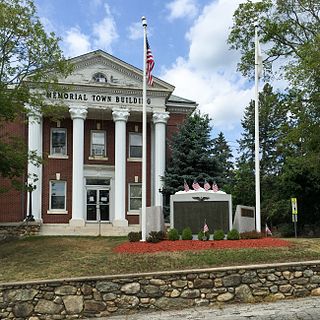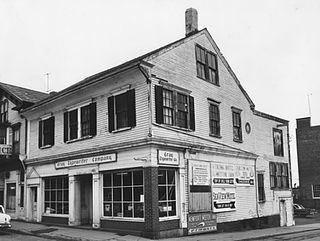
The Eleazer Arnold House is a historic house built for Eleazer Arnold in about 1693, and located in the Great Road Historic District at Lincoln, Rhode Island. It is now a National Historic Landmark owned by Historic New England, and open to the public on weekends.

Slatersville is a village on the Branch River in the town of North Smithfield, Rhode Island, United States. It includes the Slatersville Historic District, a historic district listed on the National Register of Historic Places. The historic district has been included as part of the Blackstone River Valley National Historical Park. The North Smithfield Public Library is located in Slatersville.

Smith's Castle, built in 1678, is a house museum at 55 Richard Smith Drive, near Wickford, a village in North Kingstown, Rhode Island, United States. Smith's Castle is one of the oldest houses in the state. It was designated a National Historic Landmark in 1993 as Cocumscussoc Archeological Site, due to the artifacts and information digs in the vicinity have yielded. It is located just off U.S. 1.

Carolina is a village that straddles the border of the towns of Charlestown and Richmond on the Pawcatuck River in Washington County, Rhode Island. Rhode Island Route 112 passes through the village. Carolina is identified as a census-designated place, with a population of 970 at the 2010 census.

Saylesville is a village and historic district in Lincoln, Rhode Island.

The Nightingale–Brown House is a historic house at 357 Benefit Street on College Hill in Providence, Rhode Island. It is home to the John Nicholas Brown Center for Public Humanities and Cultural Heritage at Brown University. The house is architecturally significant as one of the largest surviving wood-frame houses of the 18th century, and is historically significant as the longtime seat of the Brown family, whose members have been leaders of the Providence civic, social, and business community since the 17th century, and include nationally significant leaders of America's industrialization in the 19th century. The house was listed on the National Register of Historic Places and declared a National Historic Landmark in 1989.

The Stephen Winsor House is a historic house in Smithfield, Rhode Island, United States. The 2+1⁄2-story wood-frame house was built c. 1850–55 by Stephen Winsor, whose family had long lived in the Smithfield area and owned extensive lands there. The house is a high-quality and well-preserved example of Italianate styling, with corner pilasters, deep bracketed eaves, and pointed-arch windows in the gables. The house remained in the Winsor family until c. 1970; it is set on a handsomely landscaped property, down a winding driveway on the north side of Austin Avenue.

The William Mowry House is an historic farm house on Farnum Pike in North Smithfield, Rhode Island. It is a 2-1/2 story plank-framed house, five bays wide, with a gable roof and a large central chimney. The main entrance is centered on the main (south-facing) entry, and is enclosed within a single-story hip-roof vestibule of 20th-century construction. A small single-story ell extends to the west of the main block. The interior follows a typical center-chimney plan, with the kitchen and parlor in the front of the house, and the dining room flanked by a small pantry and bathroom in the rear. The house was built c. 1802-05 by William Mowry, whose family has owned land in the area since the 17th century.

The Charles Tillinghast House was an historic house at 243-245 Thames Street in downtown Newport, Rhode Island. It was a 2+1⁄2-story timber-frame structure, with a side-gable roof. Built c. 1710–20, it was one of the oldest buildings in the city. It was probably built by Charles Tillinghast, whose family was among the founders of Rhode Island. The house had a distinctive cove-shaped plaster cornice, typically only found on houses of this period. It was one of the first houses to be built on Thames Street.

The Angell–Ballou House is an historic house at 49 Ridge Road in Smithfield, Rhode Island, United States. The 2+1⁄2-story wood-frame structure was built c. 1800 for Jonathan Angell, a farmer and wheelwright. It is a well-preserved example of Federal style, with some high-quality woodwork and design elements more typical of Federal-style houses in sophisticated urban settings, but also showing some vernacular departures from the style. The house was sold in 1854 to Peter Ballou, in whose family it remained well into the 20th century.

The Joy Homestead, also known as the Job Joy House, is an historic house on Old Scituate Avenue in Cranston, Rhode Island. This 2+1⁄2-story gambrel-roof wood-frame house was built sometime between 1764 and 1778. It was occupied by members of the Joy family until 1884, and was acquired by the Cranston Historical Society in 1959. The house is believed to a stopping point on the first day's march in 1781 of the French Army troops en route from Providence to Yorktown during the American Revolutionary War.

The Joseph Smith House is a historic house at 109 Smithfield Road in North Providence, Rhode Island, United States. It is a 2½-story wood-frame house, six bays wide, with a shed-style addition to the rear giving it a saltbox appearance. The oldest portion of this house, built around 1705, is a classical Rhode Island stone-ender house, whose large chimney has since been completely enclosed in the structure. The lower levels of this chimney are believed to predate King Philip's War (1675–76), when the previous house was burned. The 1705 house was built by Joseph Smith, grandson of John Smith, one of Rhode Island's first settlers. It was greatly enlarged in 1762 by Daniel Jenckes, a judge from a prominent Rhode Island family, for his son, and was for many years in the hands of Jenckes' descendants. The house is the only known surviving stone-ender in North Providence.

Westcote is a historic house in Cranston, Rhode Island. This 1-1/2 story Greek Revival cottage was built c. 1843, and was originally located on Oaklawn Avenue before being moved to its present location. It was built by a member of the locally prominent Westcott family as a farmhouse, and is a well-preserved and little-altered example of vernacular Greek Revival style.

The Babcock House is a historic house also known as Whistling Chimneys, located on Main Street in the Quonochontaug section of Charlestown, Rhode Island.

The Tomaquag Rock Shelters (RI-HP-1) are a prehistoric rockshelter site off Maxson Hill Road in Hopkinton, Rhode Island. The shelters are located under two east-facing granite outcrops in the valley drained by Tomaquag Brook. First discovered in the late 1950s by Nathan Kaye, materials recovered from test excavations resulted in the dating the occupation of one shelter to 800 BCE and the other to 800 CE. Materials recovered include projectile points, stone knives, and evidence of stone tool construction. Both sites included evidence pointing to the presence of a fire pit.

Budlong Farm is an historic farmhouse in Warwick, Rhode Island. It is a 1+1⁄2-story wood-frame house, with a gambrel roof and a large central chimney. Its current entrance is asymmetrically placed on the north facade, although the original main entry was on the south side. The house was probably built sometime between 1700 and 1720 by John Budlong, whose family was one of the first to settle the area after King Philip's War. The property is a rare local example of architecture to survive from that period.

The Paine House Museum is an historic house at 7 Station Street in the village of Washington in the town Coventry, Rhode Island. The oldest portion of this large 2+1⁄2-story wood-frame house may have been built as early as 1691 by Samuel Bennett, who was known to operate a sawmill on the nearby Pawtuxet River. The house was significantly enlarged c. 1748 by Francis Brayton. His son, Francis Jr., was granted a license to operate a tavern on the premises in 1785. The property was acquired by the Paine family in 1866, whose descendants gave it to the Western Rhode Island Civic Historical Society in 1953.

Collyer Monument is an historic monument to firefighters in Mineral Spring Park, at the corner of Mineral Spring Avenue and Main Street, in Pawtucket, Rhode Island, United States. The monument was built in 1890 by the sculptor Charles Parker Dowler to honor Samuel Smith Collyer, a fallen Pawtucket Fire Chief. The life-size bronze sculpture stands atop a pedestal of Westerly granite, which has a bronze plaque depicting the fatal accident while the reverse bears an inscription. The memorial represents a significant example of monumental work of the period and an early example of local civic pride. The monument was added to the National Register of Historic Places in 1983.
Westcott House may refer to:

The Nathan Wild House is an historic building in Valatie, Columbia County, New York, United States. Built by Nathan Wild, a prominent local figure, in 1826, the original Federal-style building was continually expanded throughout the years as the Wild family's textile mills in the area flourished. The residence was added to the National Register of Historic Places in 1991 as a result of its historical and architectural significance.





















